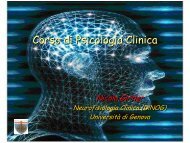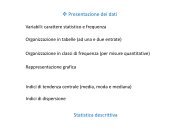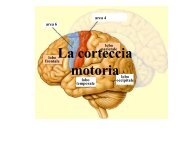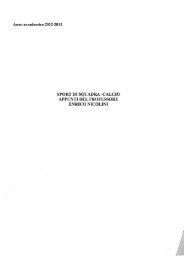LE ARTRITI MICROCRISTALLINE LE ARTRITI ... - WikiMotorio
LE ARTRITI MICROCRISTALLINE LE ARTRITI ... - WikiMotorio
LE ARTRITI MICROCRISTALLINE LE ARTRITI ... - WikiMotorio
You also want an ePaper? Increase the reach of your titles
YUMPU automatically turns print PDFs into web optimized ePapers that Google loves.
Urato monosodico<br />
Pirofosfato di calcio<br />
Idrossiapatite<br />
<strong>LE</strong> <strong>ARTRITI</strong><br />
<strong>MICROCRISTALLINE</strong><br />
1
LA GOTTA<br />
3
PERCHÉ LA GOTTA È DI PARTICOLARE<br />
INTERESSE AL GIORNO D’OGGI?<br />
• Epidemiologia con elevata frequenza<br />
• Quadro clinico in divenire (più donne, più anziani,<br />
più frequente interessamento dell’arto superiore)<br />
• Spesso non diagnosticata e trattata in modo<br />
subottimale<br />
• Nuovi meccanismi di<br />
infiammazione(inflammasoma, IL-1)<br />
• Nuovi trattamenti (febuxostat, anti IL-1, uricasi)<br />
• Utilità della diagnostica per immagini<br />
4
DEFINIZIONE DI GOTTA<br />
• Condizione determinata da un aumento della<br />
concentrazione sierica di acido urico che può<br />
causare (ma non necessariamente causa)<br />
artrite acuta (artrite gottosa), depositi di acido<br />
urico (tofi gottosi), nefropatia e calcoli renali.<br />
• Malattia dei maschi dopo la pubertà e, più<br />
raramente, della donna dopo la menopausa.<br />
• Familiarità<br />
5
STORIA NATURA<strong>LE</strong> DELLA GOTTA<br />
INFIAMMAZIONE<br />
DANNO ANATOMICO<br />
iperuricemia asintomatica attacchi acuti intermittenti gotta cronica tofacea<br />
?
Allopurinolo<br />
Febuxostat<br />
-<br />
XANTINA OSSIDASI<br />
URATO OSSIDASI<br />
(assente uomo e uccelli)<br />
IPOXANTINA<br />
XANTINA<br />
ACIDO URICO<br />
ALLANTOINA<br />
METABOLISMO DELL’ACIDO URICO<br />
Solubilità:<br />
bassa<br />
intermedia<br />
alta<br />
7
GLI IPERURICEMICI SONO PIU’<br />
INTELLIGENTI?<br />
Acido urico tipico dei primati tra i mammiferi<br />
Possibile stimolante corticale<br />
Numerosi uomini famosi della storia erano gottosi<br />
JAMA 1966; 195: 415-8<br />
8
METABOLISMO DELL’ACIDO URICO<br />
rene<br />
N H O<br />
HN<br />
N<br />
O<br />
O N<br />
Urato<br />
O N N<br />
H<br />
Acido urico nel<br />
sangue<br />
IPERPRODUZIONE difetti enzimatici<br />
alimentazione<br />
neoplasie<br />
chemioterapia<br />
psoriasi<br />
6.8 mg/dL<br />
(0.4 mmol/L) -<br />
Limite per la solubilità a 37°C<br />
IPOESCREZIONE<br />
insufficienza renale<br />
farmaci<br />
9
Pathways involved in MSU crystal-induced<br />
inflammation<br />
MSU-triggered activation of the innate<br />
immune system involves:<br />
1) Recognition of MSU crystals by<br />
components of the innate immune system<br />
2) Uptake of MSU by phagocytotic cells<br />
(e.g. macrophages)<br />
3) Activation of the NLRP3 inflammasome by<br />
MSU<br />
4) Release of IL-1β from the cell.<br />
8<br />
5<br />
Endothelium<br />
7<br />
6 Neutrophil recruitment<br />
Pro-inflammatory mediators release<br />
Busso and So Arthritis Research & Therapy 2010
Mechanisms involved in NLRP3 activation<br />
by MSU crystals<br />
1-ATP binding<br />
to P2X7R<br />
NLRP3 activation<br />
2-<br />
3-<br />
4-<br />
Modified from Bryant and Fitzgerlald 2009
PREVA<strong>LE</strong>NZA CUMULATIVA 1.4%<br />
Mikuls TR, et al. Ann Rheum Dis 2005; 64: 267-72<br />
12
PREVA<strong>LE</strong>NZA DELLA GOTTA IN VARIE<br />
AREE GEOGRAFICHE<br />
AREA CARATTERISTICHE PREV M PREV F<br />
Taiwan Nativi 15.2% 2.1%<br />
N. Zelanda Maori 13.9%<br />
UK review 0.6% 0.1%<br />
Alaska Eschimesi Inupiat 0.5% 0.1%<br />
Finlandia 0.1%<br />
Indicazioni dalle migrazioni delle popolazioni: i filippini che vivono<br />
negli USA hanno uricemia più elevata (6.1 mg/dL vs 5.1 mg/dL)<br />
e maggiore frequenza di artrite gottosa di quelli che vivono nelle<br />
Filippine.
FATTORI DI RISCHIO PER GOTTA<br />
• sesso<br />
• età<br />
• familiarità<br />
• uricemia<br />
• BMI<br />
• resistenza insulinica<br />
• Ipertensione<br />
• Insufficienza renale<br />
• Farmaci<br />
• Comobidità<br />
• fattori dietetici<br />
– carne<br />
– pesce azzurro<br />
– molluschi<br />
– alcoolici<br />
– bevande gasate<br />
zuccherate<br />
14
Bohle V et al. Arthritis Rheum 2010; 62: 1069-76<br />
15
PREVA<strong>LE</strong>NZA DELLA GOTTA IN<br />
RAPPORTO AL PESO CORPOREO<br />
Choi HK et al. Arch Int Med, 2005<br />
16
Choi HK, Curhan G. Curr Opin Rheumatol 2005; 17: 341-5<br />
Choi HK, et al. Lancet 2004; 363: 1277-1281<br />
Choi HK, et al. N Eng J Med 2004; 350: 1093-1103<br />
17
Ann Rheum Dis 2010; 69: 766-9<br />
Ann Rheum Dis 2010; 69: 1677-82<br />
19
Malattia coronarica<br />
Insufficienza renale<br />
Diabete<br />
Ipertensione<br />
20
pensare alla<br />
gotta!!<br />
valutare se la storia<br />
è compatibile<br />
non fidarsi solo della storia<br />
o del laboratorio (uricemia)<br />
cercare i<br />
cristalli !!
Criteri ACR per la diagnosi di artrite gottosa:<br />
1. Presence of monosodium urate crystals in synovial fluid AND/OR<br />
2. Tophus that contains urate crystals by chemical or polarized light<br />
microscopy AND/OR<br />
3. The presence of six of the following:<br />
a. One attack of acute arthritis<br />
b. Maximal inflammation occurring within one day<br />
c. Attack of monoarticular arthritis<br />
d. Presence of joint redness<br />
e. First metatarsophalangeal joint painful or swollen<br />
f. Unilateral attack involving first metatarsophalangeal joint<br />
g. Unilateral attack involving tarsal joint<br />
h. Suspected tophus<br />
i. Hyperuricemia<br />
j. Radiographic evidence of joint swelling<br />
k. Radiographic evidence of subcortical cysts without erosions<br />
l. Negative synovial fluid culture during acute attack<br />
24
72 pazienti con gotta (criteri ACR)<br />
87,5% maschi<br />
Età media maschi 60,5 aa<br />
Età media donne 71 aa (p=0.013)<br />
Familiarità 11,1%<br />
Zampogna G, et al. Reumatismo 2009; 61: 41-47<br />
25
• Iperuricemia<br />
• Cristalli intraarticolari<br />
• Differenze<br />
meccaniche<br />
• Differente struttura<br />
• Vulnerabilità ai traumi<br />
• Innervazione<br />
• Temperatura e pH<br />
• Composizione del<br />
liquido sinoviale<br />
• Funzionalità del<br />
drenaggio linfatico<br />
27
SC<strong>LE</strong>ROSI SISTEMICA?<br />
33
ARTROSI?<br />
34
NEOPLASIA?<br />
35
Dalbeth N, et al. Arthritis Rheum 2010; 62: 1549-56<br />
36
moderate inflammatory infiltrate<br />
subchondral bone<br />
cartilage<br />
base falange<br />
synovium<br />
tophus<br />
tophus<br />
testa metacarpale<br />
periosteum<br />
cortical bone<br />
diafisi<br />
bone marrow<br />
38
Dalbeth N, et al. Arthritis Rheum 2008; 58: 1854-65<br />
In vitro, crescita di osteoclasti<br />
39
Figure 7. A) SE T1-weighted coronal sequence of the left forefoot showing homogeneous intermediate signal intensity<br />
pattern of an intra-articular tophus of the first metatarsophalangeal joint with extension in the surrounding soft tissues.<br />
Deep erosions of the first metatarsal head and of the base of the proximal phalanx are present (arrowheads). B) TSE T2-<br />
weighted coronal sequence showing a heterogeneous intermediate to low signal intensity pattern. C) On the STIR<br />
coronal sequence a heterogeneous high signal intensity pattern is observed with a region of fluid-like signal intensity on<br />
the medial aspect of the tophus, adjacent to the phalanx base (asterisk). Bone marrow edema is also present. D and E)<br />
coronal TSE and STIR images of a tophus of the first MTP joint in another patient: note the dishomogeneous<br />
appearance of the tophaceous deposit (arrowheads), most probably due to calcification foci that were confirmed on<br />
radiographs. Bone marrow edema is also shown (arrows).<br />
40
IMAGING DELLA GOTTA<br />
Gutierrez M, et al. Reumatismo 2009; 61: 216-21<br />
41
MODIFICAZIONI DEL<strong>LE</strong> ABITUDINI DI VITA<br />
• Dieta<br />
– Ridurre l’introito di purine (ridurre carne rossa, fegato, rognone, burro,<br />
frutti di mare, molluschi, crostacei e legumi)<br />
– ridurre l’apporto di bevande addizionate di fruttosio<br />
– Aumentare l’introito di latte magro, yoghurt, proteine vegetali, ciliege, cibi<br />
ricchi in vitamina C<br />
• Diminuzione dell’introito di alcool (in particolare la birra)<br />
• Calo ponderale<br />
– 1 kg/mese (evitare le diete drastiche)<br />
– Evitare le diete ad alto contenuto proteico<br />
• Pazienti con calcolosi urinaria dovrebbero bere >2 L di acqua al giorno<br />
• Esercizio moderato<br />
Le modificazioni delle abitudini di vita hanno solo una modesta efficacia<br />
sull’uricemia (eg 10-15% di riduzione con dieta ipopurinica)<br />
42
TERAPIA DELLA GOTTA<br />
ACUTA CRONICA<br />
• Colchicina<br />
– ½ mg x 3<br />
• FANS<br />
• Corticosteroidi<br />
– Intraarticolari<br />
– Sistemici<br />
• Allopurinolo<br />
– Dosaggio fino a 900 mg<br />
• Febuxostat<br />
Il 56% dei pazienti gottosi non segue correttamente la terapia<br />
43
DEFINIZIONE DI CONDROCALCINOSI<br />
• Condizione determinata da un aumento<br />
della concentrazione locale di pirofosfato<br />
di calcio diidrato che può causare (ma non<br />
necessariamente causa) artrite acuta<br />
(artrite gottosa), o cronica.<br />
• Malattia della donna (4:1) e generalmente<br />
dell’età avanzata.<br />
• Familiarità in casi sporadici<br />
44<br />
44
Ca<br />
Fe<br />
Cu<br />
Nucleoside triphosphate<br />
<br />
<br />
45
MALATTIE METABOLICHE PREDISPONENTI<br />
ALLA CONDROCALCINOSI<br />
• Emocromatosi<br />
• Iperparatiroidismo<br />
• Ipofosfatasia<br />
• Ipomagnesiemia<br />
• Ipotiroidismo<br />
• Gotta<br />
• Acromegalia<br />
• Ipercalcemia familiare ipocalciurica<br />
46
QUADRI CLINICI CONDROCALCINOSI<br />
• Asintomatica, diagnosi solo radiologica<br />
• Artrite acuta intermittente (mono od<br />
oligoarticolare, pseudogotta)<br />
• Poliartrite cronica similreumatoide<br />
• Poliartrite cronica associata ad artrosi<br />
Ginocchio<br />
Polso<br />
Spalla<br />
Caviglia<br />
gomito<br />
Polso<br />
2-3 MCP<br />
TMC<br />
Ginocchio<br />
Spalla<br />
Caviglia<br />
gomito<br />
48



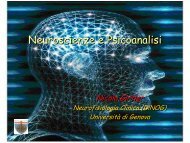
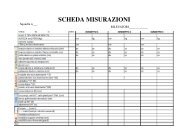


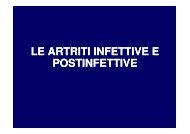
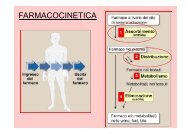
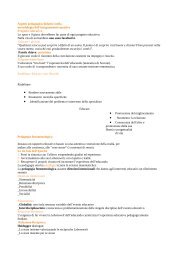
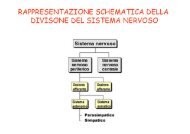
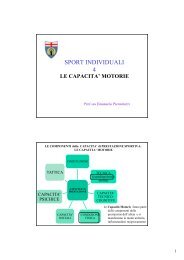
![Arti Marziali JUDO Ge Aprile2012 [modalitàcompatibilità]](https://img.yumpu.com/47286865/1/184x260/arti-marziali-judo-ge-aprile2012-modalitaa-compatibilitaa-.jpg?quality=85)
